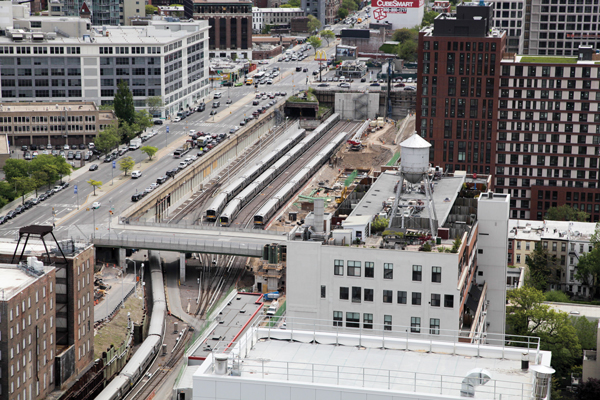Trending
Is Pacific Park in trouble again?
Brooklyn’s biggest development has been plagued by internal and external woes over the year and a half

UPDATED, Aug. 2, 8:24 a.m.: Pacific Park, developer Bruce Ratner’s baby, is now 13 years old. And like most teens, it’s going through a turbulent phase.
The 22-acre mixed-use megadevelopment, which borders five neighborhoods in Brooklyn, has been battered by a slew of internal and external troubles since its inception. When Ratner unveiled his plans for the arena-anchored project in December 2003, he claimed his firm, recently renamed Forest City New York, could complete it within a decade of winning government approval. In the years following, the development became embroiled in land seizure lawsuits, and in 2008 the market tanked. By mid-2014, Forest City had only completed the Barclays Center and had yet to complete a single apartment of its intended 6,430 rental and condominium units.
So when Greenland USA, a subsidiary of Chinese real estate giant Greenland Group, forked over $200 million for a 70 percent stake in Pacific Park in June 2014, things began to look up: Brooklyn’s real estate market was roaring, and Forest City suddenly had a deep-pocketed Chinese partner to bankroll its biggest project to date.
But now, Pacific Park’s outlook is not as rosy as three years ago. In early 2016, Forest City and Greenland began marketing stakes in three of the 15 remaining sites within the giant project. And in October, Forest City’s parent company, Forest City Realty Trust, announced a $307.6 million accounting loss on Pacific Park and said it would delay construction of new apartment buildings until further notice. Within a week, the real estate investment trust’s stock fell by 14 percent.
There have been persistent rumors of discontent within the joint venture ever since. Several sources claim Greenland is unhappy about Pacific Park’s slow progress and that both partners would sell if they found a taker. Additionally, regulatory issues, including new Chinese capital controls and the amended 421a tax abatement program, could complicate the project’s financials.
“Best plans are often run awry by market conditions,” said Ronald Dickerman, head of the real estate fund manager Madison International Realty, which jointly owns a New York retail portfolio with Forest City. He noted that softening rental rates and the “extraordinary” amount of new residential supply in Brooklyn are two of the project’s biggest challenges.
To add to the pressure, Forest City and Greenland have a deadline to meet. In an agreement with the city and the state, the two firms committed to providing 2,250 below-market rental units at Pacific Park by 2025. And with more than 10 other residential and mixed-use structures that have yet to be built, it remains unclear whether the joint venture will meet its deadline.
RXR Realty’s Seth Pinsky, who worked at the New York City Economic Development Corporation when the original deal was negotiated in 2006, said he wouldn’t be shocked if the developers didn’t deliver all the units by 2025. “These things tend to be generational,” he said, referencing past projects like Battery Park City. “They take several cycles to actually get completed.”
The partnership’s inner workings
In a recent interview with The Real Deal, MaryAnne Gilmartin, president and CEO of Forest City, dismissed the suggestion of disagreement between the partners.
“We have a partner whose money flows, and is green, and perhaps one of the most capitalistic enterprises I have ever partnered with,” Gilmartin said, meaning that she feels Greenland understands the American way of business better than most.
Greenland’s New York operation is in fact run by a hodgepodge of New York City real estate veterans and some Chinese affiliates. The firm’s Pacific Park manager, Scott Solish, was formerly a vice president at the New York City Economic Development Corporation, and Duncan Peng Dong, a Warburg Pincus veteran, serves as the company’s capital markets director. Hu Gang, who has been with Greenland USA since 2003, took over as CEO when I-Fei Chang suddenly and unexpectedly resigned in November 2015.
Rumors of discontent, Gilmartin said, came up because Greenland is “not a passive partner.” Discussions over specific buildings or how much risk to take are “deliberate collisions that we intentionally knew we would be facing” and lead to a better project, she claimed.

Indeed, while some foreign investors in New York construction projects provide capital and little else, Greenland has been involved in the day-to-day progress of Pacific Park — the two firms even share a floor at 1 Metrotech Center in Downtown Brooklyn.
But despite sharing an office, a recent incident highlights miscommunication between Forest City and Greenland. In early June, Greenland’s Hu told TRD that the joint venture would likely break ground on one or two buildings by the end of the year. Meanwhile, a few days earlier at REITWeek, an annual real estate conference, Forest City Realty Trust CEO David LaRue said there was no immediate timetable for further construction at Pacific Park. Instead, he said, the partners would wait to see the response to the 30,000 new housing units hitting the market in Brooklyn and Queens.
“As we go forward, we’re going to be able to evaluate whether or not those 30,000 units impact the market to such a degree that we should pause,” he said.
At Pacific Park’s first completed residential building, 461 Dean Street, more than 50 percent of market-rate units have been rented out since marketing launched in October, according to the developers. But several units saw price cuts of between 5 and 10 percent on StreetEasy. Monthly rents range from $2,400 for a studio to $5,391 for a two-bedroom. To compare, the average rent for two-bedroom apartments in Downtown Brooklyn was $4,727 between March 2016 and April 2017, according to brokerage MNS, and $3,176 in Park Slope, although the developers argue that the building’s location puts it in a league of its own.
Similarly, for-sale units at Pacific Park are feeling the brunt of oversupply. Between June 2015 and June 2016, the developers sold 140 condominiums at the 278-unit 550 Vanderbilt. But over the six months that followed, they sold just 27. Last month, Forest City and Greenland replaced marketing agent Corcoran Sunshine with Nest Seekers International’s Ryan Serhant. Gilmartin called the split “amicable” and said that prices for the remaining units would not be cut. At the time of the switch, the building was 65 percent sold.
Regulatory hurdles
Pacific Park was benefiting from the 421a tax abatement until the program’s revival as “Affordable New York” in April. The finer details of the new tax break create complications for the developers, according to a source close to the companies.
When planning out Pacific Park, Forest City and Greenland used a provision in the old 421a: Rather than put affordable units into every structure, they could concentrate them into single buildings and still receive abatements for the rest of the project. The developers applied that to two of the rental buildings, 535 Carlton and 38 Sixth Avenue, which are both entirely composed of affordable units, the source said on the condition of anonymity.
Under the new legislation, that provision is gone. So if the partners still want to get the tax abatement for a 245-unit condominium building at 615 Dean and a more than 300-unit rental tower at 664 Pacific Street, they may need to include affordable units in those new structures.
Still, Gilmartin claims that even if the new program poses a challenge for those two buildings, the extended abatement period could still be a financial boon for the project as a whole.
Timing still matters. Forest City and Greenland will face financial penalties if they don’t deliver the promised affordable units by 2025. If the 2,250 affordable units are not completed by the deadline, the developers will have to pay a penalty of $2,000 per month per apartment without a temporary or permanent certificate of occupancy, according to the joint venture’s agreement with Empire State Development.
Can development thrive in the REIT age?
The financial complications don’t end with the city and state. Since converting into a real estate investment trust in January 2015, Forest City has been plagued by lackluster stock performance.
Amid pressure from activist investors, Ratner and his cousin Charles stepped down from the company’s board in December 2016, and the company announced it would do away with a dual-share structure that gave the Ratner family control of the firm. The move was part of a major strategic shift that could move the company away from development projects like Pacific Park.
“Bruce Ratner is a developer, and the era of big developments is ending for Forest City,” said Paul Adornato, an analyst at BMO Capital Markets. “That’s pretty transparent.”
REIT investors tend to dislike new development because the risk and uncertain timetables make it harder to predict profits and to discern a stock’s value, analysts say.
Diversified REITs, or REITs that own properties across several asset types, tend to be equally unpopular with investors. So in the last year, Forest City Realty Trust has tried to sharpen its focus on market-rate apartments and offices. In March, the company sold 8,500 of its affordable apartments across the U.S. to Jonathan Rose Companies, and it is currently in talks to sell its stake in a portfolio of New York retail properties to Madison International.
The question is, where will that leave its New York development business and the subsidiary responsible for it, Forest City New York?
Gilmartin, who calls herself a “hopeless developer,” said it would be a waste for Forest City to abandon its place in the market as a builder. “It takes a lifetime to establish the credibility and the reputation and the partnerships that we have in New York, and to not take advantage of that going forward in a responsible and responsive way to the market just doesn’t make any sense at all,” she said.
Adornato was more skeptical. “The typical institutional investor in REITs is risk-averse. They do not want to take on excessive development risk,” he said. Playing down the firm’s involvement in the project, first by selling a stake to Greenland and later by writing it off as an impairment, is part of the firm’s “de-risking and becoming a REIT,” he noted.
Still, Adornato thinks it’s unlikely Forest City will abandon Pacific Park. For one thing, the firm has already spent around $725 million on the project’s residential portion and has written its investment down to zero on its books, according to sources. From now on, any money it makes “is all positive” from an accounting perspective, the analyst said.
Forest City’s agreement with the city and state could pose another hurdle. An attorney familiar with Pacific Park said that such agreements often include a clause requiring the developer to retain a stake.
But perhaps most importantly, it would be difficult to find a buyer for a project as complex as Pacific Park with Greenland’s money and Forest City’s expertise. And representatives for Forest City did not confirm whether or not the partnership had lined up an equity partner for the three sites it began marketing last year.
“I think they’re going to keep it going,” Dickerman of Madison International said. “I’m sure it’s not all peaches and cream, but they need each other.”
Correction: an earlier version of this post misstated the sum Greenland paid for its stake in the project.




